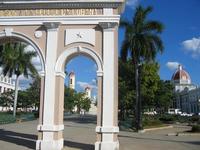You are in: Caribbean -> Cuba -> Urban Historic Centr... , and traditional search or Image Gallery will yield results of this site only
Urban Historic Centre of Cienfuegos
| Site number: | 1202 |
|
| Type of site: | Cultural | |
| Date: | 1819 | |
| Date of Inscription: | 2005 | |
| Location: | South America, Cuba, Municipality of Cienfuegos | |
Up to 75 images are shown here. Click on each for more details or on Image Gallery for more images.
Six official UN languages:
Arabic,
Chinese,
English,
French,
Russian,
Spanish
Other languages: Dutch, Finnish, German, Italian, Japanese, Luxembourgish, Norwegian-bokmål, Polish, Portuguese
Other languages: Dutch, Finnish, German, Italian, Japanese, Luxembourgish, Norwegian-bokmål, Polish, Portuguese
| Description: | Though founded in a Spanish territory (1819), the colonial town of Cienfuegos was initially settled by immigrants of French origin. The town was a trading spot for sugar cane, tobacco and coffee, as it was located in the middle of the country’s sugar cane, mango, tobacco and coffee production area, on the Caribbean coast of southern-central Cuba. Originally developing in the neoclassical style, the town later became more eclectic while still retaining a harmonious overall townscape. Among the most interesting buildings the city holds the Government Palace (City Hall), San Lorenzo School, the Bishopric, the Ferrer Palace, the former lyceum, and a number of residential houses. Cienfuegos - is the first, and an exceptional, example of an architectural ensemble, which reflected the emerging ideas of modernization, sanitation and systematic urban planning. During, as developed in nineteenth century Latin America. --WHMNet paraphrase from the description at WHC Site, where additional information is available. | |
| Cienfuegos is a city on the southern coast of Cuba, capital of the province of Cienfuegos. It is located about 250 km (155 miles) from Havana, and has a population of 150,000. The city is dubbed "La Perla del Sur". Cienfuegos literally translates to "Hundred fires". Near the entrance to the Bahia de Cienfuegos (bahia meaning "bay") is Castillo de Jagua (full name Castillo de Nuestra Señora de los Angeles de Jagua), a fortress erected in the 1745 for protection against Caribbean pirates. Cienfuegos, one of the chief seaports of Cuba, is a center of the sugar trade, as well as coffee and tobacco. While sugarcane is the chief crop, local farmers grow coffee. The downtown contains 6 buildings from 1819-50, 327 buildings from 1851-1900, and 1188 buildings from the 20th century. There is no other place in the Caribbean which contains such a remarkable cluster of Neoclassical structures. --Wikipedia. Text is available under the Creative Commons Attribution-ShareAlike License. | ||
| Source: | http://whc.unesco.org/en/list/1202 | |
| Reference: | 1. UNESCO World Heritage Center, Site Page. | |




































